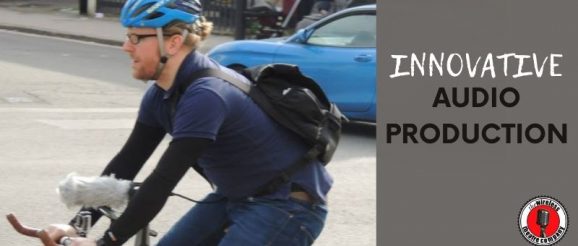Innovation In Audio Drama – Wireless Theatre

George Maddocks looks back on the early days of Wireless Theatre
Current conversations about innovation in audio drama sparked memories of early Wireless productions for George, who was heavily involved in our audio and video work, along with countless other insanely talented and committed people. Heartfelt thanks to all.
“It’s worth remembering that Wireless Theatre was in and of itself innovative from the start. MP3s had been the preserve of Napster, Limewire and other shady practices, Wireless took those and made them into a distribution method to a whole different demographic who were ready for the internet but didn’t know it. Wireless’ approach to innovation was extremely practical. If we had a good idea and we understood the practicalities of how to make it work then we did it.
From my perspective the following were the broad themes and the associated practical innovations that followed from this attitude.
“we gave ourselves the freedom to fail”
It started with the Wired Up Theatre Podcast. Even in the early 2010’s a podcast wasn’t that innovative, but we committed very heavily to on-location recording, so we ended up with a traditional podcast i.e. two people and mic in a room but also added in a bunch of magazine style on-location recordings from around London (if memory serves the highlight was a bar crawl disguised as a review of Theatre bars, although the best bits of that were edited out on account of revolting language). Probably because the magazine style recordings were taking too long to edit we canned that podcast after 2 – 3 episodes.
Simultaneously we were doing long form documentaries that benefited from the on location recording. Quite shortly after all that we set up Wired Up Media (WUM), where we developed the Wireless stuff that was experimental (so we gave ourselves the freedom to fail without concern for the main brand). The most common theme to WUM was on-location recording. On-location recording was chosen because it was quite clear that the world was moving away from downloads and into streaming. In a streaming scenario you have to satisfy people’s desire to binge so more materials need to be recorded and recorded faster.
By removing the requirement to record in a studio we dropped the recording cost and by recording on a single mic in long single takes (essentially acting out the scene in the same location it’s meant to be in) we reduced the recording time without compromising on quality. Consistently throughout 2010 to 2017 we recorded on-location and reduced recording times. This built on the work Wireless had already done with live recordings in theatres (Stage Fright at the London Horror Festival etc). By the end, we were in a position to record, edit and distribute an audio play in 48hrs (Rat) and on one occasion, improvised, wrote and recorded an entire play in 72 hrs (Amelie’s Party).
In parallel we were experimenting with video. The BBC had a big drive on ‘visualizing audio’ at that point. No-one quite knew what it was at the time (it turned out it was just putting webcams in studios) but it was worth experimenting with. Often our video work was used to document the audio recording we were doing, however the extra time and cost it took to process and edit video meant we were less successful getting the videos released. There are some notable exceptions, Lost Theatre’s Five-Minute plays, where we had to film, edit and get ten pieces online by midnight each day for four days.
White Noise, a pure video piece beautifully put together by real professionals and ruined by the director’s puerile humour [Editor’s note: White Noise was directed by George Maddocks], Stage Fright, Rat and Dead London (more on that later).
However, for every video we got out there was one that got filmed but never left the editing booth (Stage Fright 2, Buxton Festival, The Making of Amelie’s Party, The Sci-Fi Festival). WUM’s video work did in the end lead to the creation of a lightweight portable live streaming rig that could be carried by a single person and used to livestream video from multiple cameras from any venue with Internet of a cellular signal. Had we combined this with the portable on-location audio recording rig we built for the Edinburgh festival then we would have had a setup that could be built in an afternoon and used to stream live radio plays and video from anywhere.
However, by the time WUM were this capable with video as well as audio we had been obliged to transition away from making films simply because the cost of video equipment, data to stream and logistic planning costs prohibited it.
Looking back, the point where all things were in alignment was Dead London. The audio was recorded on location in a single day, the ‘visualized audio’ video was then recorded in a single day following that. Crucially the visualized audio wasn’t just a ‘making of’ it told a separate story, partly via invented social media accounts and fake news footage created by us. It was shot cheaply, not quite with found equipment but certainly with equipment accessible to many, then put together on a pair of Mac books. The whole piece was then played back to a live audience.”
